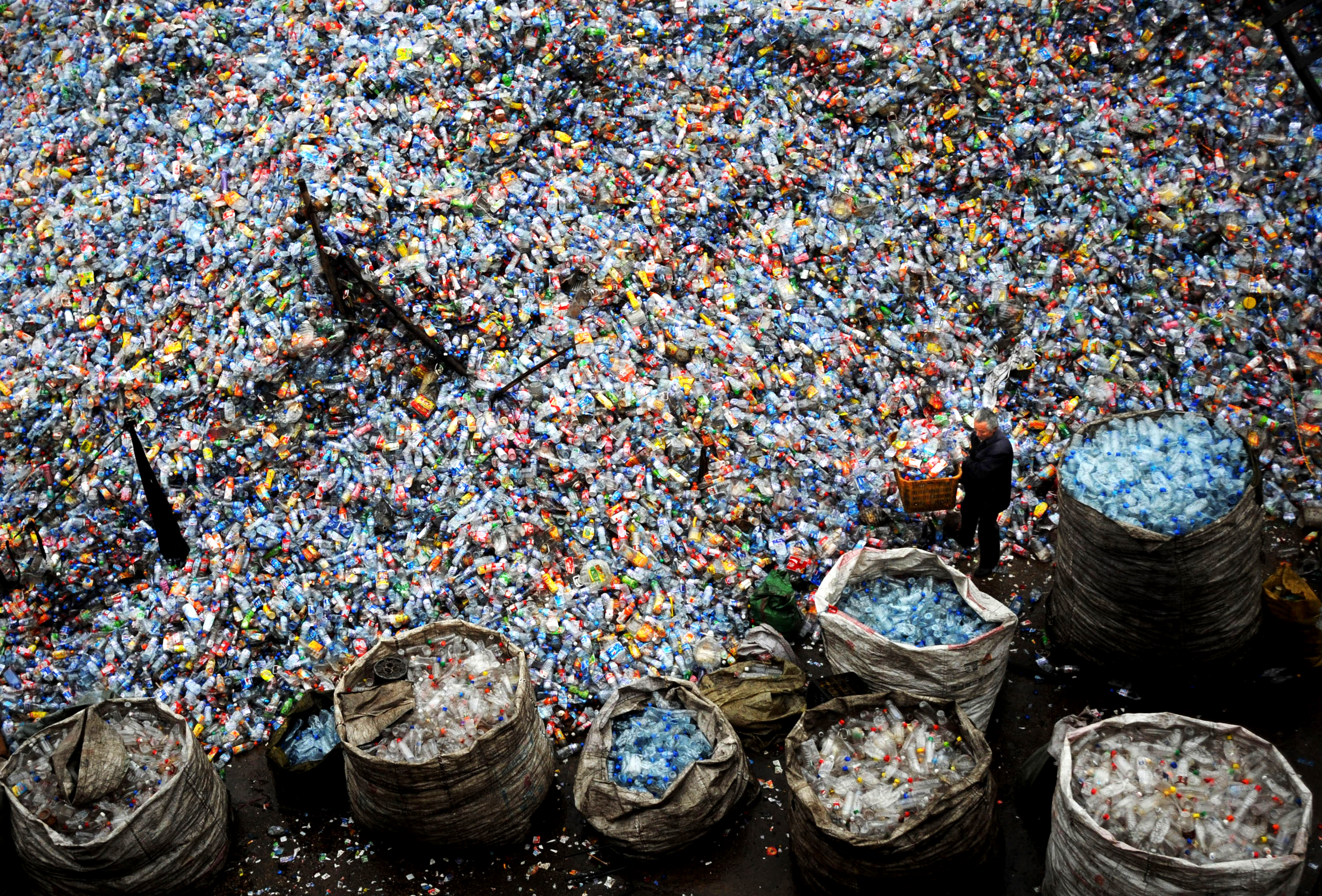Plastics everywhere
Microplastics permeate the globe from the oceans’ depths to the highest mountaintop — and our bodies.

Microplastics permeate the globe from the oceans' depths to the highest mountaintop — and our bodies. Here's everything you need to know:
What are microplastics?
They're tiny shreds of plastic found in our air, water, and soil, ranging from 5 mm — about the size of a grain of rice — to less than a micron. Human beings have produced more than 8 billion metric tons of plastic since the 1950s, less than 10 percent of which has been recycled. As a result, phenomenal amounts of plastic waste fill our rivers, oceans, and shorelines. Plastic doesn't biodegrade over time — it just breaks down into ever-smaller particles. In addition to bottles, utensils, straws, and other single-use plastics, sources include car tires, cigarette butts, packaging, fishing nets, and polyester fabrics, which collectively have shed trillions of microfibers. Since scientists first became concerned about microplastics a few decades ago, they've been stunned to learn these tiny particles quite literally blanket the globe. They've been found in Arctic snow, in soil samples from Swiss nature reserves, on Mount Everest, and in the Pacific Ocean's Mariana Trench — 7 miles below the surface. "Nowhere — no matter how remote — is immune," said Alan Jamieson, a Newcastle University scientist who has found plastic fibers in the stomachs of deepwater sea creatures. Microplastics are also increasingly found in our bodies.
The Week
Escape your echo chamber. Get the facts behind the news, plus analysis from multiple perspectives.

Sign up for The Week's Free Newsletters
From our morning news briefing to a weekly Good News Newsletter, get the best of The Week delivered directly to your inbox.
From our morning news briefing to a weekly Good News Newsletter, get the best of The Week delivered directly to your inbox.
Where in our bodies?
A pair of studies unveiled in March and April found microscopic particles in subjects' blood and deep in their lungs. In the blood study, a team of Dutch scientists found plastics — including those used to make beverage bottles and packaging — in samples from 17 out of 22 healthy blood donors. In the lung study, researchers from the U.K.'s Hull York Medical School took 13 lung samples from surgical patients and found microplastics in 11 of them, including samples from deep in the lower lungs. Microplastics have been found in stool samples and in the placentas of unborn babies. That latter finding was "very worrying," said Elizabeth Salter Green of Chem Trust, a U.K. charity focused on chemical harm. "Babies are being born pre-polluted."
Why is plastic in people?
We eat, drink, and breathe it. Trace amounts of plastic have made their way into the food chain; plastic also directly leeches into food from packaging and containers. A 2019 analysis by the World Wildlife Fund estimated that people consume up to 5 grams of plastic a week — about the same amount of plastic in a credit card. Microplastics have been found in shellfish, salt, beer, fresh fruit, and especially drinking water. A global study in 2017 found plastic fibers in 83 percent of tap-water samples — and bottled water is far worse. British researchers also have found that bottle-fed babies swallow daily millions of microplastic particles shed into milk from plastic bottles, an amount that one researcher said left him "absolutely gobsmacked." We also breathe in plastic in microfibers that float invisibly in the air, many shed by clothing, fabric, and other textiles. A 2020 study found that 11 national parks and protected lands in the American West were showered every year by more than 1,000 metric tons of microplastic-particles — the equivalent of 300 million pulverized plastic bottles.
A free daily email with the biggest news stories of the day – and the best features from TheWeek.com
How harmful is this?
That's the key question, and the short answer is, we don't know. Now that scientists have found microplastics in lungs and blood, said Laura Sadofsky of Hull York Medical School, "The next step is, so what? Does it matter?" The research is in its infancy. Studies have found that plastics contain chemicals that can act as "endocrine disruptors," meaning they can affect and even mimic hormones; in theory, this means microplastics in the body may cause cancer, reproductive disorders, chronic inflammation, autoimmune diseases, obesity, and neurological impairment in developing fetuses and children. The plastics industry argues that its products are largely inert in the body and are shed in wastes. But many experts are inclined to agree with Trinity College Dublin environmental engineer Dunzhu Li, who says, "I think it's fair to say the potential risk might be high."
What can be done?
We need to cut our prodigious consumption of single-use plastic and keep what we do use out of the environment. In March, representatives of 175 nations agreed to start work on a global treaty to cut plastic pollution, designed to be in place by 2024. Its aims include cutting plastic use, boosting recycling, and cleaning up waste. In the U.S., California just became the first state to embark on an ambitious plan to curb microplastics, in part by cutting single-use plastics. But those trying to find solutions are swimming against a strong, microplastic-filled tide: Global plastic consumption is expected to double over the next 20 years, according to the World Economic Forum. If there's no change in consumption trends, the group says, by 2050 there could be more plastic in the ocean pound for pound than fish.
The dirty secret of plastic recycling
Americans worried about plastic pollution might feel they're making a difference when they separate their bottles and takeout containers for recycling — but those efforts may not mean much. Only a small fraction of plastic waste is repurposed, and that amount is dropping even as plastic production climbs. Last year, the U.S.'s plastic recycling rate dipped below 6 percent, down from a peak of 9.5 percent in 2014, according to a new report by the groups Beyond Plastic and The Last Beach Cleanup. The rate dropped after China stopped buying U.S. plastic wastes in 2017. Environmentalists say the plastics industry has sold the public on the illusion that plastic is recyclable, when in fact the process is prohibitively expensive, and few U.S. facilities have the capacity to do it. Most of the plastic set aside for recycling winds up in landfills or is burned. Accusing petrochemical companies of "a half-century campaign of deception," last month California Attorney General Rob Bonta opened an investigation into their role in misleading consumers. The plastics industry "must stop lying to the public about plastics recycling," said Judith Enck of Beyond Plastics. "It does not work, it never will work, and no amount of false advertising will change that."
This article was first published in the latest issue of The Week magazine. If you want to read more like it, you can try six risk-free issues of the magazine here.
-
 Kissing bug disease has a growing presence in the US
Kissing bug disease has a growing presence in the USThe explainer The disease has yielded a steady stream of cases in the last 10 years
-
 How worried should we be about microplastics in our brains?
How worried should we be about microplastics in our brains?The Explainer Average human brain contains enough plastic fragments to make a spoon
-
 The hidden cost of lead exposure on American mental health
The hidden cost of lead exposure on American mental healthUnder The Radar Millions of mental health diagnoses have been linked to childhood lead exposure in new study
-
 US bans final type of asbestos
US bans final type of asbestosSpeed Read Exposure to asbestos causes about 40,000 deaths in the U.S. each year
-
 'TikTok brain' may be coming for your kid's attention span
'TikTok brain' may be coming for your kid's attention spanThe Explainer What happens to kids' brains when they binge TikTok's endless stream of bite-sized videos?
-
 A tropical skin disease is making the rounds in the US
A tropical skin disease is making the rounds in the USSpeed Read Leishmaniasis is endemic to the country and can cause ulcers and disfiguration
-
 Animals and plants that have been used to fight disease
Animals and plants that have been used to fight diseaseThe Explainer The world's flora and fauna have long been medically important
-
 Heat harms the brain more than we think
Heat harms the brain more than we thinkWarmer temperatures could be affecting us mentally


